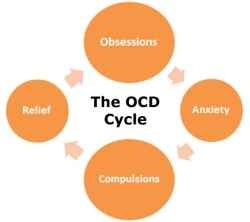Have you ever gotten a thought stuck in your brain, akin to an awful pop tune from the eighties that just keeps replaying in your mind and won’t go away? A person I’ll call Rachel came to me to help her with a horrifying obsessive thought that was starting to affect her daily functioning. In it, she was being destroyed by a plague of locusts, much like the one that had attacked Egypt in biblical times.
 A successful physics professor at a West Coast university, Rachel needed professional help for this recurring, obsessive thought, which had become so vivid over the years that living with it had become almost unbearable. She tried five years of psychotherapy, and then switched to a psychiatrist, who recommended medications that were ineffective and caused unpleasant side effects. Finally, the patient tried a “geographic cure”– a sabbatical to New York. But Rachel continued to experience the terrifying obsessive thoughts. At that point, she was referred to me.
A successful physics professor at a West Coast university, Rachel needed professional help for this recurring, obsessive thought, which had become so vivid over the years that living with it had become almost unbearable. She tried five years of psychotherapy, and then switched to a psychiatrist, who recommended medications that were ineffective and caused unpleasant side effects. Finally, the patient tried a “geographic cure”– a sabbatical to New York. But Rachel continued to experience the terrifying obsessive thoughts. At that point, she was referred to me.
As always, I took a thorough history. I then explained the type of treatment I had in mind. The time frame was to be three or four sessions lasting 90 minutes each. I planned to apply two cognitive techniques and one behavior modification strategy to treat the patient’s obsessive thoughts.
First, we discussed the P&P (possibility and probability) concept. There was certainly a possibility that the locusts could attack her (this generated some humor), but the probability of this happening was significantly slim. As a physicist, she easily related to that concept. That discussion lasted about 30 minutes.
Next, we discussed Newton’s third law of motion: For every action, there is an equal and opposite reaction. When translated into her treatment strategy, this became “for every thought, there is an equal and opposite thought.”
She easily accepted that theory, and it helped to relieve the anxiety of her obsessive thoughts. Taken further, that concept evolved into thinking that for every thought there is a lesser thought — and possibly even no thought. The no-thought concept helps the patient get long-term relief from the obsessive thought.
Finally, we applied the practice of thought stopping. Thought stopping is a method in which the patient induces the thought that is so distressful and is then taught how to stop it. We used guided imagery to induce the terrifying thought of the locust attack.
Here’s how it worked: I asked Rachel to imagine a large movie screen, onto which I invited her to project the scene she had so often envisioned. As she progressed into this stressful imagery, I made a loud noise by hitting my desk with a ruler and simultaneously shouting “Stop!” In that procedure, the image she was thinking or projecting was automatically interrupted, blocked, and stopped. We practiced several times. After six trials, I stopped using the ruler and just shouted “Stop!” It worked. As we proceeded through this technique, Rachel began to take over the entire strategy and began to shout the word “Stop” to control the obsessive thought.
Moving along, we reached a point at which she was able to subvocalize the word “stop” and get the same result as if an outside force had interrupted, blocked, and stopped the thought.
Rachel’s treatment was completed in three 90-minute visits. She was quite pleased that she had gained control over her obsessive thoughts. To reinforce our work together, we audio taped the sessions so she could review them whenever the obsessive thinking began to recur. Having learned how to use the movie-screen approach to project an obsessive thought, Rachel now had a tool she could use on her own. I explained that she could also change images from the obsessive thought to a pleasant scene to help reduce the anxiety that the thought produced.
When Rachel returned to her university, she resumed her thriving and demanding academic career free of that terrifying obsessive thought.
Behavioral treatments like these are hard work, for both the therapist and the patient. Often, we need to structure the treatment to the patient’s thinking, career, and lifestyle, as I did in this case by using the laws of physics for the physics professor. In this, as in so many cases, I am continually amazed at how resilient and changeable the human mind is when people really want to heal, and customized cognitive and behavioral approaches have proven time and again to provide a quick and effective solution.
* * * * *
This blog aims to present psychiatric/psychological information to a general readership, offering insights into a variety of emotional disorders, as well as social issues that affect our emotional well-being. It includes the ideas and opinions of Dr. London and other leading experts. This blog does not provide psychotherapy or personal advice, which should only be done by a mental health care professional during a personal evaluation.







